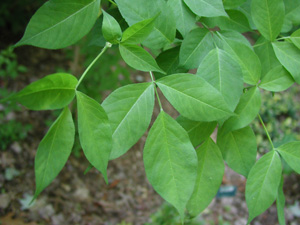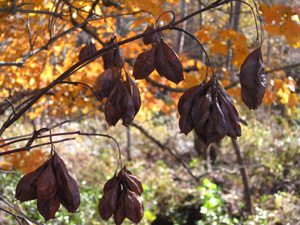Resource Library
Plant of the Week: Bladdernut
The University of Arkansas System Division of Agriculture does not promote, support or recommend plants featured in "Plant of the Week." Please consult your local Extension office for plants suitable for your region.
Plant of the Week
Bladdernut
Latin: Staphylea trifolia

Most of our native American shrubs founder in obscurity in the nursery industry. A few, such as Itea and Fothergilla, have attained a modicum of prominence in the trade, but by and large it can be said we love our native trees and ignore our native shrubs. Bladdernut (Staphylea trifolia) is just one example of an interesting native that lacks that special something needed to push it to stardom.
Bladdernut is a stoloniferous but clump-forming deciduous shrub of the bladdernut family, a small group of three mostly tropical genera and 40 species scattered about the northern hemisphere. The genus Staphylea consists of a dozen species, with two found in North America, one in Europe and the rest in China and other parts of Asia. Staphylea trifolia is widely native in the east from Ontario to the eastern edge of the Great Plains, and south as far as northern Mississippi. It is usually found on northern slopes of wooded hillsides, or in the floodplain of rivers and streams. One reference says it has a preference for limestone-based soils, but this requirement does not seem mandatory.
It usually grows 10 to 12 feet tall and wide, but really old specimens can take on the form of a small, multi-stemmed tree. Stems are greenish on young growth but turn brown with age. Leaves are opposite and compound, with three equal-sized ovate leaflets to 3 inches long. New growth is bright green, but as the leaves age they turn dark green. Fall color is a clear yellow, but is not often expressed in the wild, as plants are often found in deep shade.
Bell-shaped, greenish white flowers to one-half inch across are produced in late spring in drooping panicles after the leaves have emerged, hiding what would otherwise be a handsome display. Soon after flowering, the seed pods begin forming, which are a three-lobed inflated capsule to 1 ½ inches long. During the early part of the growing season, the capsules are chartreuse, but as the season progresses, they turn brown. The pods remain on the plants into the winter, making it easy to identify even after its leaves have fallen.

Bladdernut’s lack of commercial appeal revolves around a couple factors. First, it isn’t an evergreen, and American gardeners love evergreens. Next, it’s a bit large and nondescript – just another large blob of a plant with interesting but not outstanding features. And finally, it has never had a champion to tirelessly promote it and extol its modest virtues. The shrub is offered by native plant nurseries, but don’t expect to find it at a local garden center.
Like many native plants, bladdernut grows much better in the garden than in the wild. In the wild, it is often open and a bit gangly, but in gardens it forms compact, well-branched mounds that can be maintained at any reasonable height by pruning. It responds so well to pruning that at least one maze has been built using it as the plant of choice.
Though seldom seen in gardens, it is best used as an edge-of-the-woods plant or as a component of the woodland shade garden, especially along streamsides. It is hardy from zone 4 in the north through zone 8 in the south. Propagation is easy by cuttings, division or seed, which requires a cold, moist stratification treatment to break dormancy.
By: Gerald Klingaman, retired
Retired Extension Horticulturist - Ornamentals
Extension News - October 21, 2011
The University of Arkansas System Division of Agriculture does not maintain lists of retail outlets where these plants can be purchased. Please check your local nursery or other retail outlets to ask about the availability of these plants for your growing area.